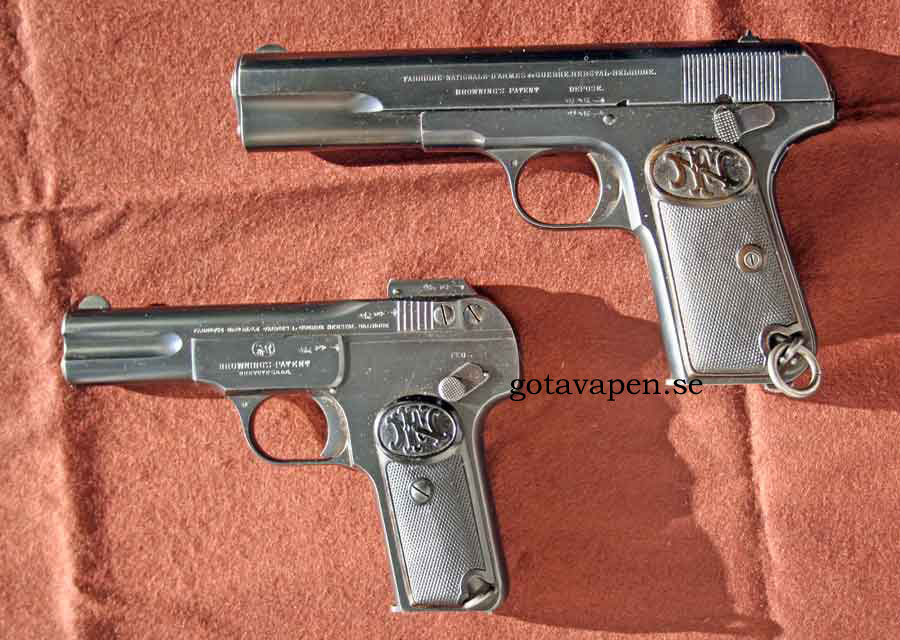
Swedish Pistol m/1907
Text by O. Janson
updated 2009-01-19
Page 1/6
 |
| The two Browning pistols in the military commission test. On top M1903 and below M1900 |
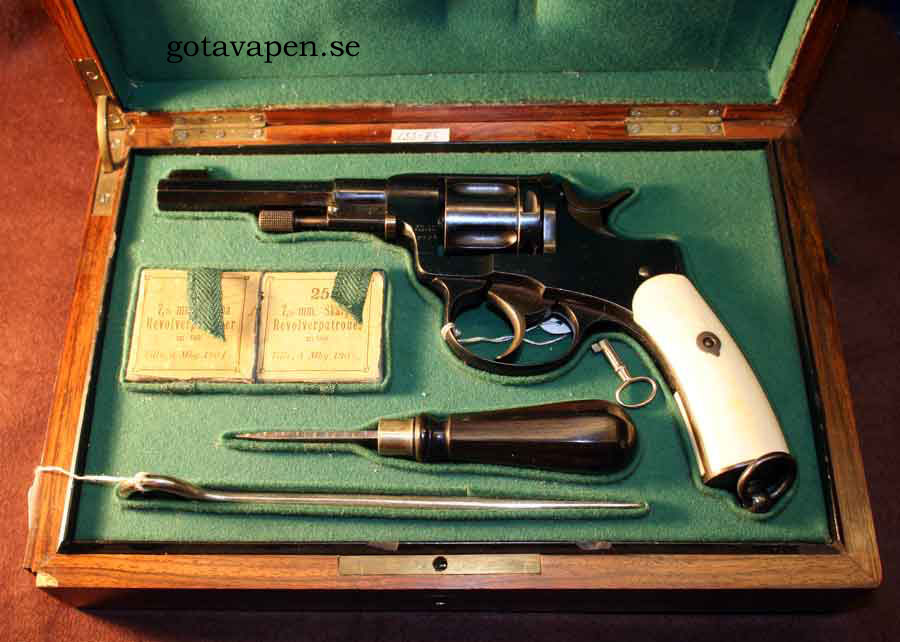 |
|
Swedish 7,5 mm Nagant revolver known as revolver m/1887 |
|
1987 Sweden had adopted a 7,5 mm Nagant revolver known as revolver m/1887. 1904 there was a military commission in Sweden which searched for an up to date pistol for the Swedish officers instead of the old revolver m/1887. The following pistols were used for this trial were:
Specifications for the different guns and their cartridges appears below: |
| Weapon | Calibre | Weight | Length | Crtg length | Bullet Weight gram |
Bullet Weight grain |
V10 m/s | V10 fps |
| Luger | 30 Luger (7,65 Para) | 0,89 kg | 237 mm | 30 mm | 6,0 | 93 | 333 | 1092 |
| Browning M1900 | 32 ACP (7,65 ACP) | 0,63 kg | 163 mm | 25 mm | 4,6 | 71 | 288 | 945 |
| Colt-Browning | 38 Colt Auto | 1,00 kg | 230 mm | 32 mm | 8,3 | 129 | 295 | 968 |
| Mannlicher pistol |
7,63 mm | 0,83 kg | 230 mm | 28 mm | 5,6 | 87 | 270 | 886 |
| Mannlicher carbinepistol |
7,65 mm | 0,99 kg | 270 mm | 35 mm | 5,6 | 87 | 341 | 1119 |
| Hamilton | 6,50 mm | 1,20 kg | 270 mm | 30 mm | 4,1 | 64 | 228 | 748 |
| Browning M1903 | 9 mm Brown. Long | 0,96 kg | 200 mm | 28 mm | 7,1 | 110 | 318 | 1043 |
| Frommer | 8 mm | 1,05 kg | 275 mm | 31 mm | 7,4 | 115 | 278 | 912 |
| Revolver m/1887 | 7,5 mm | 0,80 | 240 mm | 35 mm | 6,7 | 104 | 223 | 732 |
|
The test showed that the two best pistols were the Luger and the Browning M1903. The conclusion of the report was that the Luger was superior concerning precision, but the function was less reliable than the Browning M1903. This became very apparent in cold climate. |
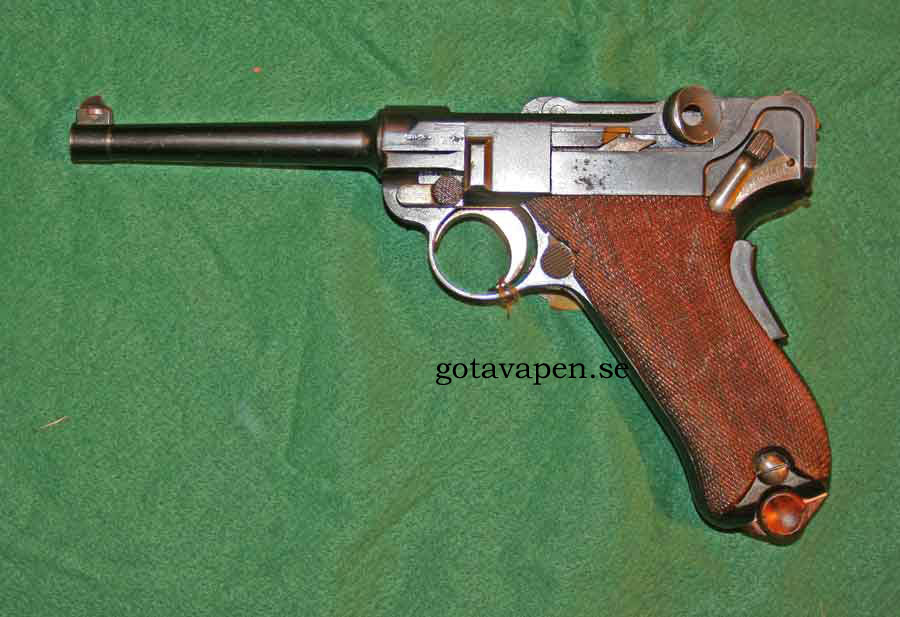 |
|
Luger 1900 in 30 Luger (7,65 Parabellum), which was used for the Swedish trial. |
|
In February 1902 John Moses Browning visited FN for the first time. With him, he brought the first prototype for M1903. Basically it was an improved M1900 in 9 mm Browning Long (9x20 mm).
FN made these pistols until 1914, when Germany occupied the plant. After the war up to 1927 FN assembled these pistols from spare parts. Only 58 442 Pistol M1903 were made by FN all together for contracts to Sweden, Russia (5 000 pcs which often were equipped with extra wooden shoulder stock - see pictures), Paraguay and Turkey. |
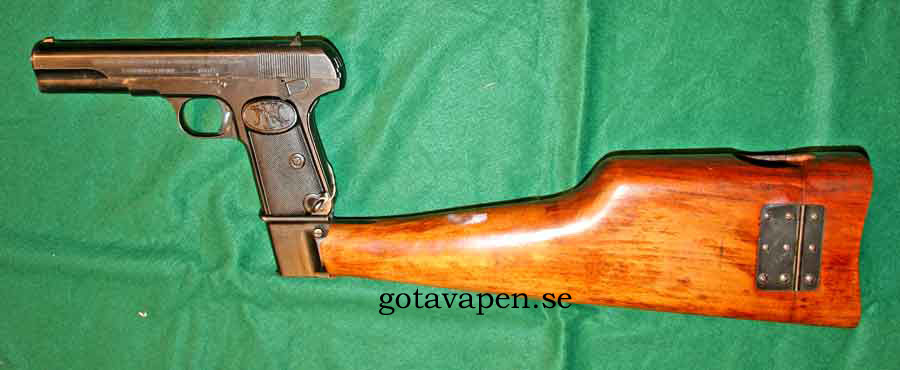 |
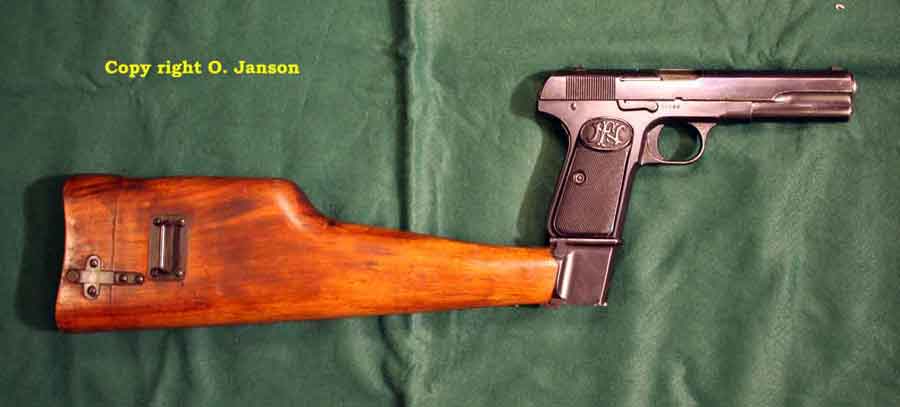 |
|
The FN M1903 was also delivered with a wooden stock attached to an extended 10 shot magazine. There are no reports that this type of wooden stock took part in the tests, although there was a very high interest for carbines instead of pistols among the leading militaries at that time. |
|
The conclusion of the report was that the Luger was superior concerning precision but the function was less reliable than the Browning M1903. This became very apparent in cold climate.
Some changes had been made: The extractor and the safety had been strengthened. A ring for the lanyard was added at the bottom of the grip. |
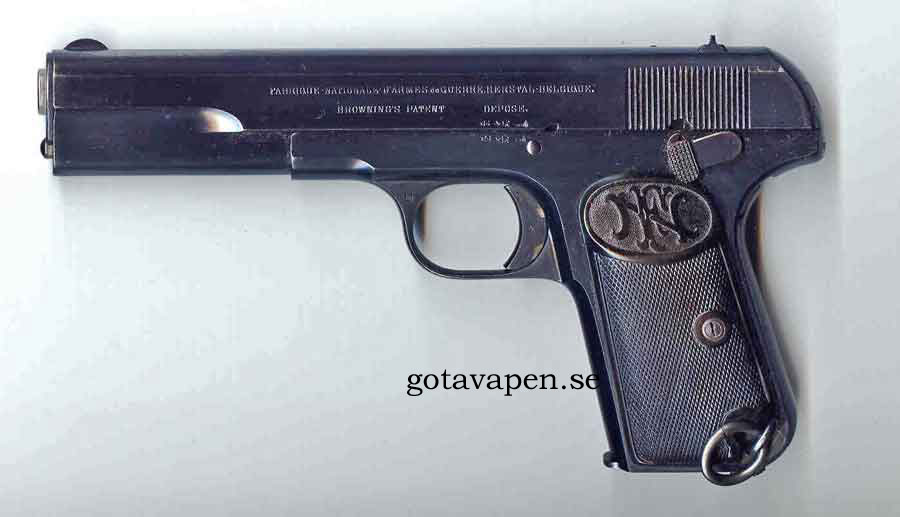 |
|
Here is a military contract pistol m/1907 made by FN 1910 for Sweden. |
|
The Pistol M1903 was accepted as Swedish Pistol m/1907 on the 16th of December 1907. The first 10 000 pistols were made by Fabrique National d’Armes de Guerre, Herstal in Belgium. They were bought from the Swedish agent Paul Berghaus AB in Gothenburg. All pistols delivered were checked out by Carl Gustafs Stads gun factory in Eskilstuna. It is easy to see if one of the m/1907 has been used by the armed forces because of these stamps at the rear end of the pistol. The inspector’s initials will appear under the Swedish crown. The Swedish defence forces are responsible for control of weapons. Since 1890 - 1942 the Swedish Carl Gustaf Gun Factory made these tests under dominion of the Royal Army administration. Here are the codes / inspectors marks for the Swedish Military small arms >>> |
 |
The most common initials on the Belgian made m/1907 are HC (Hyltén-Cavallius) and CJ (Carl Edward Johansson) Staff Sergeant First Class Carl Edward Johansson was also called “Measure Johansson” and he is world famous for his kit with combined measures which still is used for high accuracy. This m/1907 was made by FN 1910
|
|
|
Here a HVA m/1907 from 1917: TT for Tor Thorsson and HK for Helge Koltoff |
|
|
|
From left: FN pure Civilian; Husqvarna Civilian / military; Tor Thorsson & Helge Koltoff, Gustaf Bjorkenstam; Husqvarna Civilian / military |
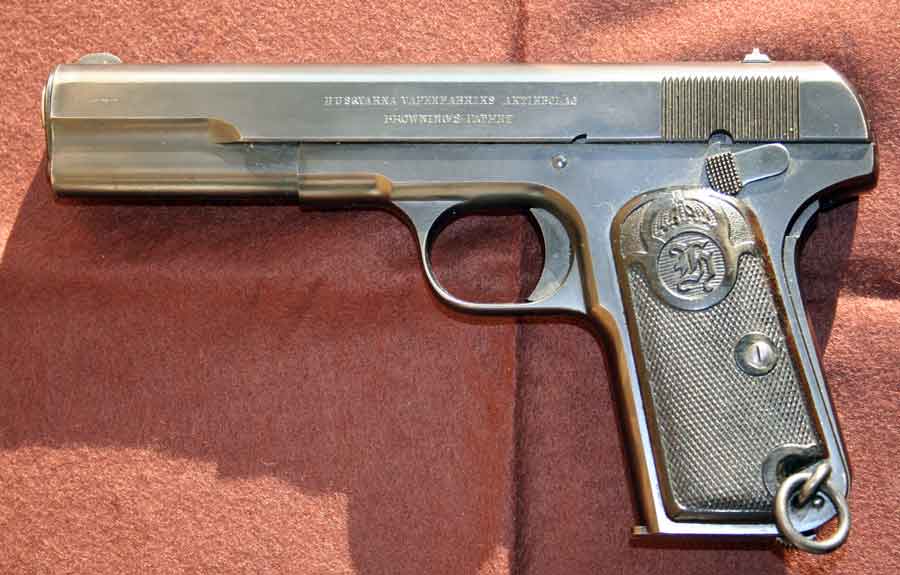 |
| HUSQVARNA VAPENFABRIKS AKTIEBOLAG;
BROWNINGS PATENT
This pistol was one of the first pistols Husqvarna made (1917 ). |
|
When Germany occupied Belgium 1914 the deliveries of m/1907 ceased from FN. Sweden took the decision to build the pistol at Husqvarna Vapenfabrik. The tools for the production were not ready until 1917, when the production of the Swedish pistol m/1907 started in Sweden. There are two parallel lines of numbers – one civilian (normally marked H) and one military. Lack of military pistols during WW2 resulted in that civilian produced pistols became military with military acceptance markings with a complete confusion of numbers as the result. There are as I said civilian m/07 which became military and military which became civilians. There are FN produced pistols (M1903) which are without any acceptance stamps as well as HVA this indicates that the pistol was sold directly to a civilian from Berghaus in case of FN or from HVA as the civilian model No 500. These pistol were produced at Husqvarna Vapenfabrik until 1941 when HVA started to make pistol m/1940. After that 584 pistols m/1907 were put together by old spare parts until 1942. Still when the pistols were sent for destruction by the turn of the millennium there were enough spare parts to make more than 200 pistols out of them.
|
|
There are five different texts on the slide of the Husqvarna pistols due to when they were made. The oldest text was: 1. Husqvarna Vapenfabriks Aktiebolag Brownings Patent. |
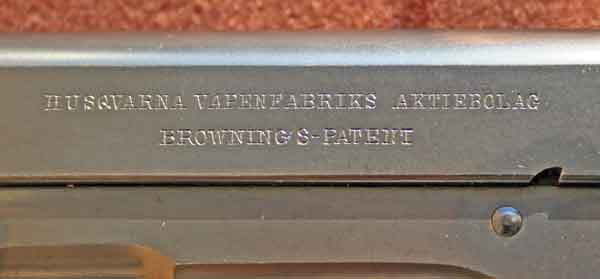 |
This is the oldest type of text on the HVA m/1907. Husqvarna Vapenfabriks Aktiebolag "BROWNINGS PATENT" |
 |
As you can see it is very close to the text on the one made by FN. Husqvarna Vapenfabriks Aktiebolag "BROWNINGS PATENT" This was something FN opposed to 1919. |
|
FN did not like this text with Browning’s Patent and wrote 1919 a letter to Husqvarna and threatened with an application for a summons if they didn't change the text. The text was changed to: 2. Husqvarna Vapenfabriks Aktiebolag, System Browning. |
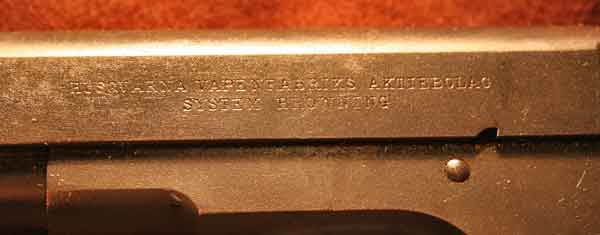 |
This is the second type of text: Husqvarna Vapenfabriks Aktiebolag "SYSTEM BROWNING"
|
|
Next step was to leave the text about Browning all together. From about 1930 the text was: 3. Husqvarna Vapenfabriks Aktiebolag. This text is common on both military and civilian guns. This text also appears on a picture of No 500 in the civilian arms catalogue from HVA from 1932. All these different texts above are found on both military and civilian produced pistols. |
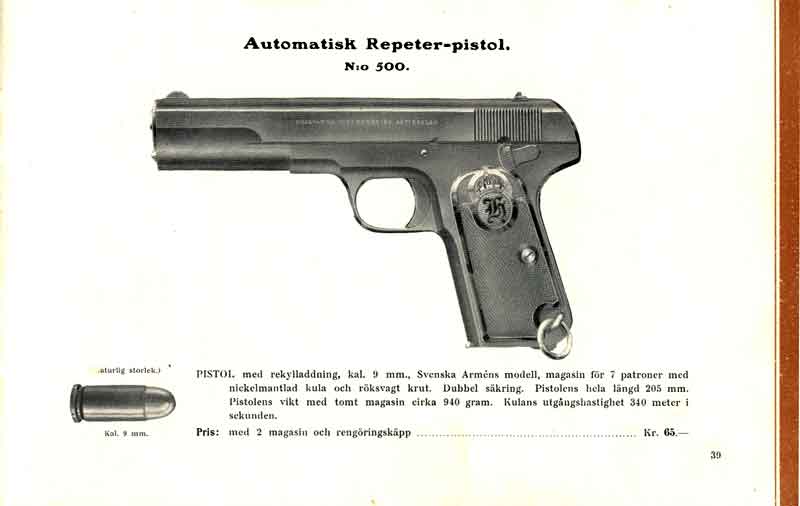 |
|
Here you can see a page in the Husqvarna catalogue from 1932 were the civilian pistol was offered for 65 Swedish krona (€ 7.00 or $ 9.00). |
|
|
|
Text: HUSQVARNA VAPENFABRIKS AKTIEBOLAG This gun belonged to the Air force and the serial number starts with "F". |
|
4. Husqvarna Vapenfabriks AB This short variant has also been reported on single specimens.
5. Slide without any text. This is a pistol for the civilian market and also been reported on single specimens. |
|
All FN made pistols should be beautifully polished and browned deep blue like the first Husqvarna made. Later HVA were blasted with sand and blued. If you find a pistol of old type sand blasted, then it most likely has been sent for refurbishing and sandblasted afterwards. Note the pistol from 1918 below. |
|
|
|
|
|
HUSQVARNA VAPENFABRIKS AKTIEBOLAG; BROWNINGS PATENT This HVA from 1918 was refurbished much later, sand blasted and blued. |
|
It occurs that pistols also are marked with the ID of the military unit. These markings start with
The pistols from the navy sometimes are found with three arm mark called “cat foot”. If you find a pistol with I 15 it indicates that the pistol has belonged to a specific regiment “I 15” for Infantry regiment No 15. The pistols were also used by other army personnel like medics and signallers. During training services the pistol was exchanged for a dummy pistol officially called m/28. The dummy should, when carried in the field, have the lanyard loop. |
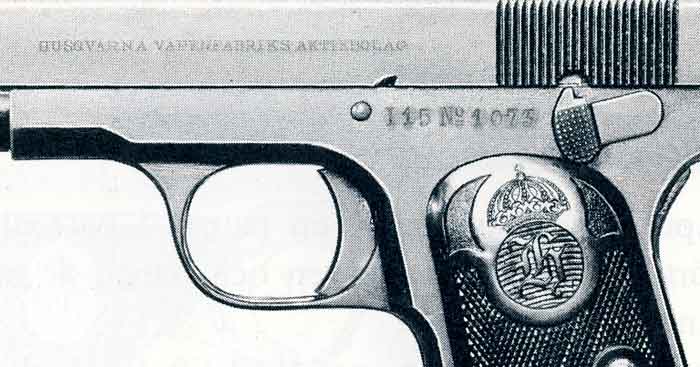 |
Note I 15 No 1073
for Infantry
regiment pistol No 1073 and the slide text "Husqvarna Vapenfabriks Aktiebolag" (picture from a Swedish army manual 1969) |
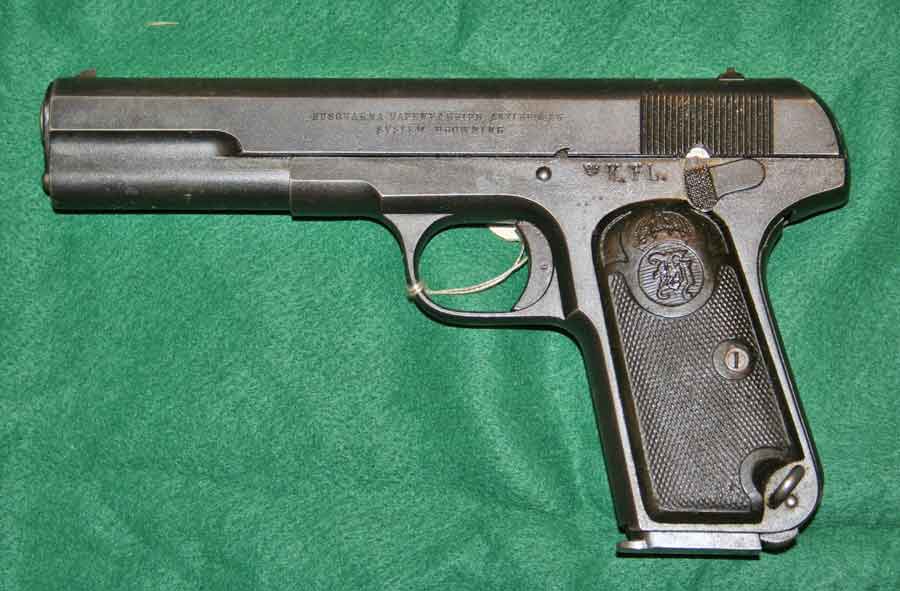 |
|
"HUSQVARNA VAPENFABRIKS AKTIEBOLAG SYSTEM BROWNING" for the Royal Navy = K. FL. |
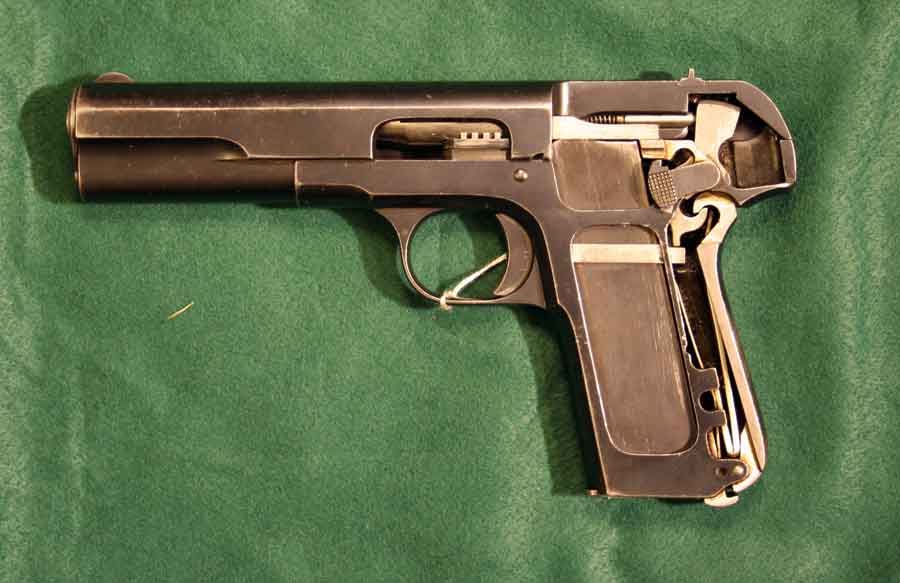 |
|
Here is one of the instruction pistol m/1907. It has been cut carefully but it is still fully functioning. It can be fired and shot with!
|
 |
The substitute for pistol
m/1907:
Dummy pistol called m/28 |
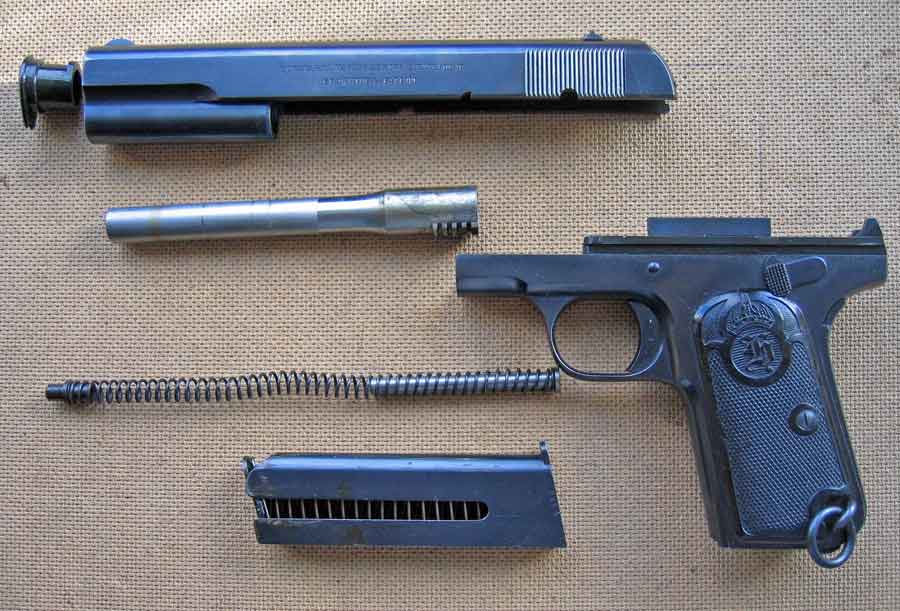 |
|
Field strip of the m/1907 |
|
The pistol m/1907 should from the beginning be carried in a holster called m/1908. At the end of its service the pistol was carried in one of the front pockets of the battle belt. Very often the officers cheated during field training and only kept the lanyard loop going to the pocket without any pistol. The Navy used a black holster called m/10. |
|
Officers were allowed to purchase their own holsters according to standard but with minor modifications.
|
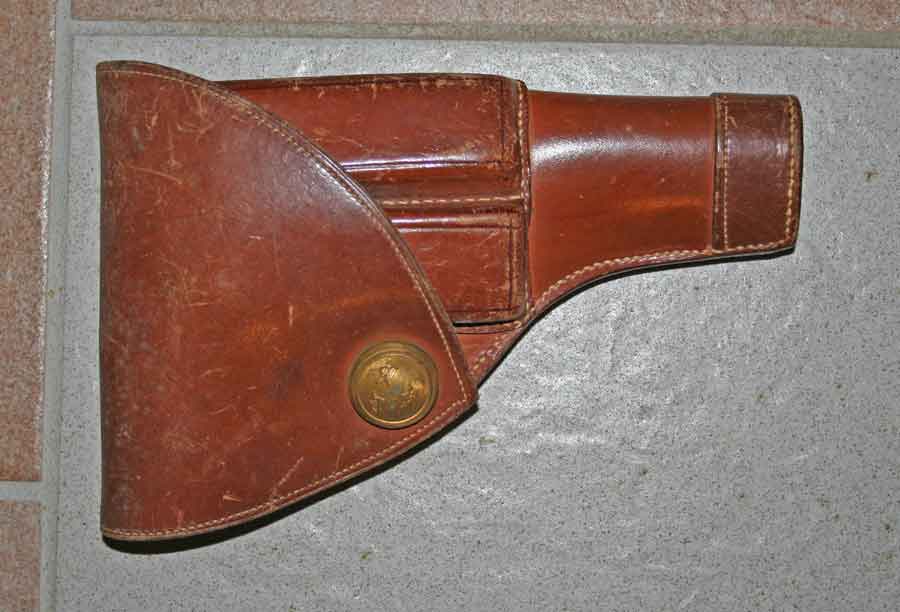 |
|
This is a typical officer’s purchased holster with similar button on the holster like on the officer’s uniform jacket. |
|
|
This is another purchased officer’s holster |
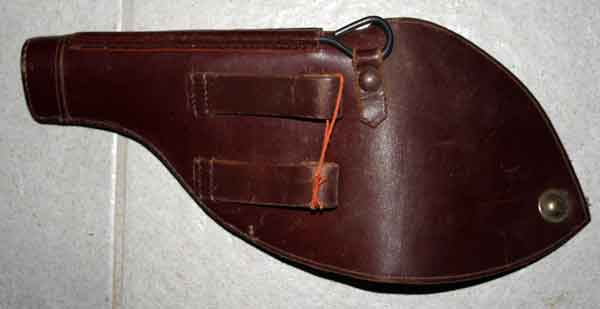 |
with cleaning rod on the back side.
|
 |
Typical for these holsters are that they are lined. |
 |
Standard military holster
for pistol m/1907. Note "T4" - stamp for
|
|
There were tests made to alter the m/07 to 9x19 mm cartridge m/39 after the acceptance of the Walther HP as pistol m/39. These pistols are equipped with 9 mm Parabellum barrels, stronger recoil spring and the magazines were changed. There are reports that 10 pistols from FN and 15 pistols from Husqvarna were changed. The system turned out to be too weak and the tests were finished.
|
 |
The three Swedish service pistols 1939 - 1945
Pistol m/1907
Pistol m/1939 (Walther HP)
Pistol m/1940
|
|
The story should be over 1942 when the Finnish pistol Lathi Swedish m/40 started to be produced in large numbers. This was not the case, because when Sweden accepted the heavy armour piercing submachine gun cartridge 9 mm called m/39b (with red seal), the m/40 could not stand the heavy submachine gun ammo. When I made my military service during the 1970:s I used both m/07 and m/40 pistols. The m/1940 is although it’s very clumsy much easier to shoot with than m/1907, but the m/1907 is much smother to pack and more safe to handle. |
| Specifications: | Calibre | Weight | Length |
| Pistol m/1907 | 9 mm Brown. Long (9x20 mm) | 0,96 kg | 200 mm |
|
Specifications for the Swedish military cartridge 9 mm sk ptr m/07 (1960): |
|
|
Length over all |
28 mm |
| Weight total | 10,9 gram = 169 grain |
| Bullet weight | 7,1 gram = 110 grain |
| Powder | Pkr II (Pistol powder II) |
| Weight of powder | 0,33 gram = 5,1 grain |
| Velocity at 12,5 m | 340 m/s = 1115 fps |
| Weight of brass | 3,5 gram = 54 grain |
| Primer | 5 mm primer No 1 |
|
Pressure |
2400 bar |
| 1 box contain | 28 crtgs |
| 1 big
pack -
1 package
(2940 crtgs = 105 small boxes with each 28 crtgs) |
weights 41 kg |
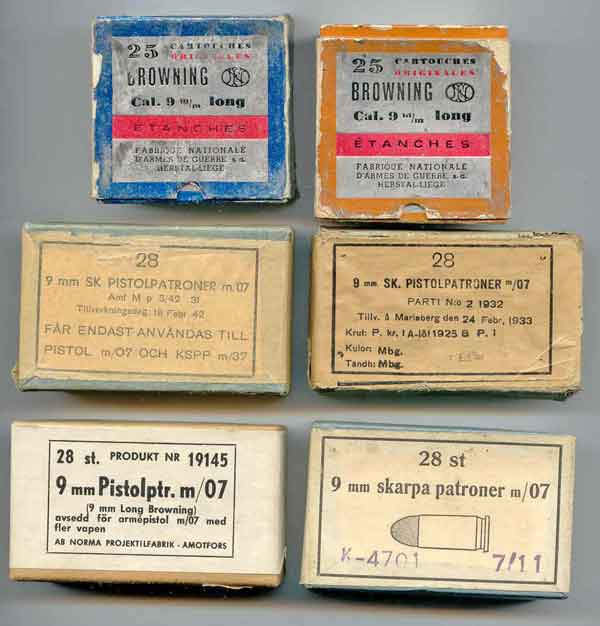 |
Six different boxes of ammunition for the pistol m/1907: Top line: 2 civilian boxes made by FN (sold by Berghaus) Middle line: Military boxes from 1942 and from 1933 Bottom
line:
|
|
Production of pistol m/1907 per year |
||
| Year of delivery | Military | Civilia |
| 1917 | 2854 | 209 |
| 1918 | 9361 | 817 |
| 1919 | 9000 | 93 |
| 1920 | 6000 | 140 |
| 1921 | 10303 | 59 |
| 1922 | 2750 | 48 |
| 1923 | 4250 | 40 |
| 1924 | 3000 | 38 |
| 1925 | 38 | |
| 1926 | 800 | 21 |
| 1927-1932 | 632 | |
| 1933 | 1000 | 53 |
| 1934-1937 | 564 | |
| 1938 | 900 | 112 |
| 1939 | 2025 | 95 |
| 1940 | 25653 | 2021 |
| 1941 | 10290 | 210 |
| 1942 | 400 | 171 |
| 1943 | 13 | |
| Sum: | 89231 | 4729 |
| Total pistols | 93 960 made according to HVA | |
|
References: Jimmy Johansson |
| Gothia Arms Historical Society in English | |
| Pistol m/1940 | |
| Gothia Arms Historical Society in Swedish |
|
|
|
|
|
|
|
|